
A Quantitative Approach to its Functioning and Compliance With its Decisions
This article addresses one of the central concerns in current discussions surrounding the functioning of the Inter-American System of Human Rights Protection (IASPHR): its effectiveness. Several questions necessary for a richer debate regarding the strengthening of the IASPHR lack definite answers and have still not been analyzed in as much detail as possible. To illuminate some points of the problems involved, the present article details the results of a quantitative research project focused on the degree of compliance with decisions adopted within the framework of the system of petitions of the American Convention on Human Rights (ACHR). The information presented here is the result of a survey of all of the measures adopted in all of the final decisions of the IACHR and the Inter-American Court, within the framework of the individual petition-based system of the ACHR, during a period — either recommendations or friendly settlements approved by the IACHR or holdings of the Inter-American Court—, and observes, among other aspects, the degree of compliance that the said remedies have received as of the present date. The results of this investigation may serve as a foundation for detecting useful trends for the discussion on possible reforms for optimizing the functioning of the IASPHR and in order to make strategic use of litigation before its protection bodies.
In a region of failing democracies and persistent violations of rights, the Inter-American Commission on Human Rights (the Commission or IACHR) and the Inter-American Court of Human Rights (the Court or the Inter-American Court) may contribute to positively shape state behavior. Both bodies, in fact, answer to thousands of victims by means of the petition-based system established in the American Convention on Human Rights (ACHR) and have set standards that, to a greater or lesser degree, have guided some important legal and political reforms in the countries of the region.
All in all, in discussions surrounding the functioning of the Inter-American System of Human Rights Protection (IASPHR) a central and constant concern is the matter of its effectiveness. For many observers, the human and financial resources of the IASPHR for providing an answer to the denial of rights are insufficient1. Others emphasize the absence of formal mechanisms or consolidated practices that ensure state implementation of Inter-American decisions. For some years now, a debate has existed surrounding the IASPHR within the framework of the Organization of American States (OAS) Permanent Council’s Committee on Political and Juridical Affairs (CPJA), and many states and organizations have drafted proposals aimed at strengthening the IASPHR (MÉXICO, 2008)2 . The widespread perception is, so to speak, that the IASPHR could or should exert greater influence on state behavior than it currently does.
This research sheds light on a matter strongly related to this widespread concern: the degrees of compliance with the decisions adopted within the framework of the ACHR petition-based system. Despite the repeated need for strengthening the IASPHR and increasing its influence, answers must still be found for several relevant questions for richer and more detailed debates and analysis. To what extent are the decisions of the IASPHR effectively observed? Is it possible to reach a shared and empirically sustainable description to provide an answer? Is it possible to consistently measure over time the variations in the degrees of observance of the Inter-American decisions? Of course, there is no definite answer to these questions, but an attempt may be made to conduct an exercise that would contribute to clarifying some points of the problems involved.
Here, we shall focus on the measures available to the IASPHR, within the petition-based framework, to respond to violations of rights within the ACHR. In other words, the remedies that the IASPHR offers in relation to a denial of rights declared as such through the procedures made available by the ACHR. The information presented here, in this way, surveys all the remedies adopted – whether recommended, authorized or ordered – in all final decisions of the IACHR and the Inter-American Court for a certain period of time, and observes the degrees of compliance with such remedies up to the present date3. The simple idea behind this survey is to offer modeled and quantitative information about a topic that continues to present itself through mainly narrative approaches in the literature on the IASPHR. Our task, consequently, is to contribute to answering, with the help of some quantitative tools, two central questions: What are the remedies adopted by the Inter-American petition-based system? And, to what extent are they observed?
The results of this research may serve as a foundation for detecting useful trends for the discussion on possible reforms for optimizing the functioning of the IASPHR and methods that may be advisable for making strategic use of litigation before its protection bodies.
First, we present the research. Then, we present the results obtained. Finally, we analyze said results and formulate some recommendations that may help to optimize the effectiveness of the IASPHR.
Our universe of study is composed of all of the final reports on the merits of the IACHR (Art. 51 ACHR), all of the IACHR reports of approval of friendly settlements (Art. 49 ACHR) and all of the holdings of the Inter-American Court between June 1, 2001 and June 30, 2006 with respect to state members of the ACHR who have accepted the contentious jurisdiction of the Inter-American Court. Thus, we have revised 12 final reports on the merits, 39 friendly settlements approved by the Commission, and 41 holdings of the Court. These 92 decisions contain, in turn, 462 remedies adopted by the IASPHR: 45 of them were recommended in final reports of the IACHR, 160 were settled by friendly settlements, and 257 were ordered by the Court in judgments on the merits.
In all of the decisions surveyed, we have identified, in addition to the remedies adopted and the dates on which they were observed4, the litigants before the IASPHR, the state party involved and the duration of the trial from the date of the presentation of the petition until the date of the final decision on the merits5.
The decision to restrict the universe of cases to those decided with respect to states that have accepted the jurisdiction of the Court seeks to avoid false comparisons when showing trends of compliance. The states that have accepted the jurisdiction of the Court have demonstrated a commitment – at least a formal one – with respect to the decisions of the protection bodies of the Inter-American human rights system. Those who have not accepted such jurisdiction seem to have adopted different criteria in subjecting the rules of their legal-political system to Inter-American standards, and the comparison between them could lead to mistaken conclusions.
The survey did neither include cases in the process of reaching friendly settlements nor those friendly settlements that have not yet been approved by the IACHR. This is because friendly settlements are only made known subsequent to their approval; the friendly settlement proceedings are not public. On the other hand, while unapproved settlements have effects between the State and the petitioners, they may be appealed before the system and their state of compliance may begin to be evaluated by the Commission only after their approval.
We have also not taken into account remedies recommended in the preliminary report established in Article 50 of the ACHR. Given that it is reserved, this information may only be extracted from the account of the case’s proceedings included by IACHR in Art. 51 reports, or in its claims before the Inter-American Court. Nevertheless, an exhaustive analysis of these components from the years 2001 to 2006 offers imprecise and insufficient information for determining the degree of compliance with the recommendations made by the IACHR in the preliminary report.
Finally, the time period covered by the survey is determined by the implementation, in June 2001, of the reform of the Rules of Procedure of the Inter-American Court. This, to some extent, modified the proceedings before the Court and, thus, the procedural conduct of the litigants before the system. The deadline, fixed in June 2006, obeys the need for selecting a period that is recent enough so as to reflect a practice that is as current as possible, but also far enough removed so as to analyze cases in which states have had time to adopt measures necessary for complying with the recommendations, commitments, or orders. In this sense, we consider that two and a half years is a sufficient amount of time for states to comply with the recommended, agreed or ordered measures. Thus, studying decisions made between June 2001 and the middle of 2006 allows for arriving at conclusions to which it would be difficult to raise objections, based on insufficient time for state compliance with the decisions.
The degree of compliance with each of the remedies adopted was surveyed up until the drafting of the present article6. As a result, all of the IACHR annual reports from the years 2002 to 20087 and all of the resolutions supervising compliance with the Court’s holdings (rulings?) up until June 30, 2009 have been surveyed8.
Some clarifications are necessary. In its resolutions supervising judgments, the Court evaluates the degree of compliance with each of the measures ordered. In order to define the degree of compliance of each of the remedies ordered by the Inter-American Court, this research has always followed the Court’s conclusions.
On the contrary, the IACHR evaluates the degree of compliance of the group of measures accepted or recommended, without specifically referring to each one of them. This prevented us from following the criterion of the Commission to establish the degree of compliance. For the present purposes, available information about each case has been studied—whether it was brought by the state or petitioners— under the following criteria: as long as the state has taken actions that had concrete results aimed at complying with the measure, the remedy was classified as having been partially satisfied. In cases in which the state had only begun taking steps that hadn’t produced concrete results, the remedy was considered as not satisfied. In some punctual cases, the IACHR made explicit statements regarding compliance with each remedy. The criteria of these cases have been followed. The same has been done in those cases in which the IACHR has declared full compliance with measures, even when petitioners have expressed their disagreement.
In the final decisions of cases processed through the petition-based system during the surveyed period, the protection bodies of the IASPHR adopted 462 remedies, the study of which suggests that the remedies that the IASPHR regularly adopts are directed towards satisfying four central objectives. First, the reparation of persons or groups. This is carried out through monetary economic compensation, non-monetary economic compensation, symbolic reparations, and the restitution of rights. Second, the prevention of future violations of rights through training public officers, raising social awareness, introducing legal reforms, creating or reforming institutions, and other preventive measures. Third, the investigation and punishment of human rights violations, an action that may occasionally require legal reforms. Finally, the protection of victims and witnesses. Within this framework, the remedies adopted by the IASPHR may be classified in 13 groups that may be distinguished both in terms of the type of action required from the State and in terms of the measure’s recipient or beneficiary:
i. Monetary economic compensation: a measure required of states consisting of the payment of sums of money to individuals or groups9.
ii. Non-monetary economic compensation: a measure aimed at providing access to a specific service or good or at allocating money for its provision or purchase. For example, scholarships and medical assistance, the creation of funds for productive community development aimed towards creating health, housing, and education programs, or land and real state cession.
iii. Symbolic reparations: a remedy aimed at dignifying and making moral reparations to victims and making the state’s recognition of its responsibility publicly known. This category includes: placing plaques, making public acts, giving the names of victims to establishments, streets, scholarships, or public spaces, publicly spreading Court rulings or IACHR reports, and other forms of commemorating the violations and their victims. The restitution and transfer of victims’ remains to their family members is also included as a symbolic reparation10.
iv. Restitution of rights reparation: a remedy for restoring to victims the enjoyment of their violated rights, when the action required is not of an eminently economic content. For example, reassigning an employee to the position from which he or she was terminated, replacing illegitimately removed judicial officials to their official positions, liberating detained persons, leaving sentences without effect, holding new trials with due process guarantees, excluding the victim from criminal background records, re-registering a person in pension systems or providing security measures for displaced persons to return to inhabit their land.
v. Prevention through training public officials: training or educating, in specific subjects related to human rights protection, public employees and officials, such as members of police or military security forces, of the public administration or the judiciary.
vi. Prevention through raising social awareness: launching programs or media or public education campaigns, seeking to generate awareness in society regarding matters necessary for the defense of human rights. They go beyond the mere commemoration of the verified violation in a case and homage to its victims to disseminate and promote human rights in general.
vii. Prevention through legal reforms : legislative, administrative or decree-related reforms aimed at implementing new public policies or improvement of existing ones. The recommendations, commitments or orders to pass a law or sanction a decree with the purpose of creating or strengthening a specific public institution are excluded from this category.
viii. Prevention through strengthening, creating, or reforming public institutions. For example, recommendations, commitments, and orders to do what is necessary in order to comply with domestic legislation, the violation of which undermined certain rights.
ix. Prevention through unspecified measures: a recommendation or commitment to do what is necessary to avoid the repetition of rights violations such as those of the case. These include only those recommendations that do not specify, by any means, which actions the state must take in order to be in compliance.
x. Investigation and punishment with legal reform: recommendations, commitments, or orders to investigate and punish human rights violations that demand, for their fulfillment, that the state carry out legal reforms (in a broad sense) or reforms to its justice system. For example, by repealing amnesty laws or pardons, or modifying relevant legal or jurisprudential criteria to be applied to the action ruled upon or the prescription of the action.
xi. Investigation and punishment without legal reform: investigating and sanctioning identified human rights violations, compliance with which does not require the modification of the law. This deals with cases where justice may be served without having to overcome legal obstacles11.
xii. Protection of victims and witnesses: specific protection measures for victims or witnesses based on the expectation that they will be persecuted for resorting to the Inter-American system or for having participated in internal investigation processes of human rights violations. This will be analyzed as an independent category because it demands actions that are distinct and autonomous from the central proceedings and because there could be cases in which the state completely complies with the investigation and punishment of violations without complying with the protection of witnesses, and vice versa. On the other hand, this measure does not seek reparations nor aims at generically preventing human rights violations. This is restricted to the protection of specific persons indicated by the Court or the Commission.
xiii. Others. All of those measures recommended, committed, or ordered to the state that cannot be classified within any of the 12 categories above. In the surveyed universe, we have identified three: the order that a permission to leave the country be delivered to a minor (a measure not aimed at the minor’s protection as a witness or victim, but rather to spare the minor’s mother from distressing procedures); an order for establishing communication between specific persons and the authorities for the provision of health care, and the order to deliver a legislative CD to a person.
Out of the total of 462 remedies surveyed, the group aimed at making reparations to affected persons or groups, either through symbolic, monetary, or non-monetary economic reparations or the restitution of rights, represents 61%. The prevention of future violations represents 22%. 15% of the remedies adopted aim at investigating and sanctioning those responsible for human rights violations, and protection measures for victims and witnesses comprise 1.3% of the cases. Four remedies that represent 0.7% of the universe are grouped in the “Others” category.
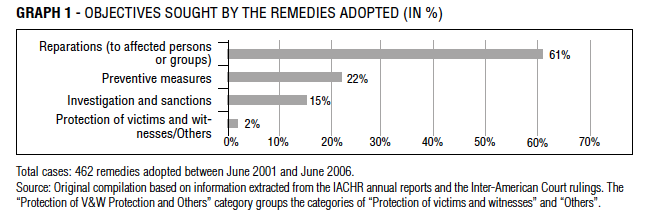
Upon analyzing the percentage of incidence of each one of the types of remedies, it is observed that 21% of the total remedies demanded are symbolic reparations, 19% are monetary reparations, and 13% are non-monetary economic reparations. The remedies that include the duty to investigate and sanction without legal reforms represent 13%, while those that did require reforms represent 9%. Another 9% of the remedies are reparation measures through the restitution of rights. Prevention measures through institutional strengthening, innovation, or reform represent 8% of the total, and among the remaining six categories of remedies, the three of a preventive nature (training officials, raising social awareness, and non-specific preventive measures) represent a joint 5% of the remedies, while the remaining three (investigating and punishing with legal reforms, protection of victims and witnesses, and others) represent 3.7 %.
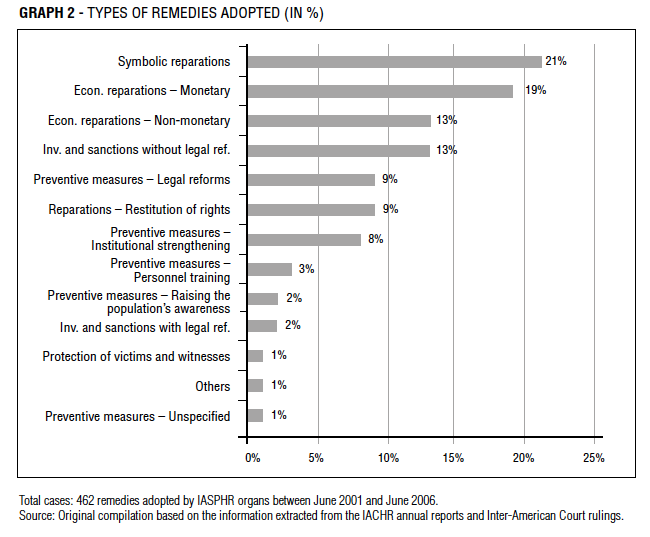
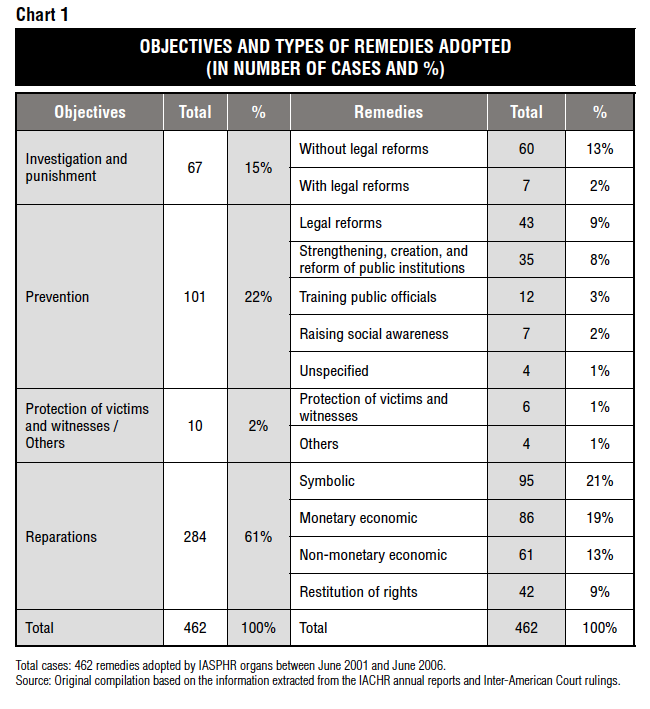
Up to this point we have detailed the objectives and types of remedies ordered by the control bodies of the IASPHR, as well as the proportions in which they have been ordered. In this section, the relationship between the types of IASPHR decisions and the different remedies adopted is analyzed. In this study, it is observed that, in reports established by Articles 49 and 51 of the ACHR, as well as in the rulings of the Court, there is a clear predominance of reparations. Of the 45 remedies recommended in the Commission’s final reports, 17 require reparations (38%), of which 12 are of an economic-monetary nature, 4 are non-monetary economic reparations and 1 is symbolic. As regards the Court’s rulings, of a total 257 remedies, 174 reparations were ordered (68%), of which 72 are symbolic reparations, 42 are monetary, 34 are non-monetary economic reparations, and 26 involve the restitution of rights. In friendly settlements, of a total of 160 remedies approved/agreed, 93 are reparations (58%), among which 32 are monetary, 22 are symbolic, 23 are non-monetary economic reparations, and 16 involve the restitution of rights.
On the other hand, upon comparing the remedies agreed upon in the framework of processes of friendly settlements with those that the Court ordered, it is observed that in the former, practically no measures of legal reform have been agreed upon. No commitments to investigate and punish requiring legal reforms are found in any of the friendly settlement solutions, and only 10 remedies demanding legal reforms as a preventive measure were identified. However, in the same period, the Court ordered the investigation of human rights violations and the punishment of those responsible with the additional obligation of reforming domestic legislation on 6 occasions, and in 27 opportunities it ordered legal reforms as a preventive measure. Something similar occurs with the recommendations of the IACHR in its ACHR Art. 51 reports. The largest amount of remedies identified in them refers to the duty to investigate and punish, but without demanding legal reforms to comply with the obligation.
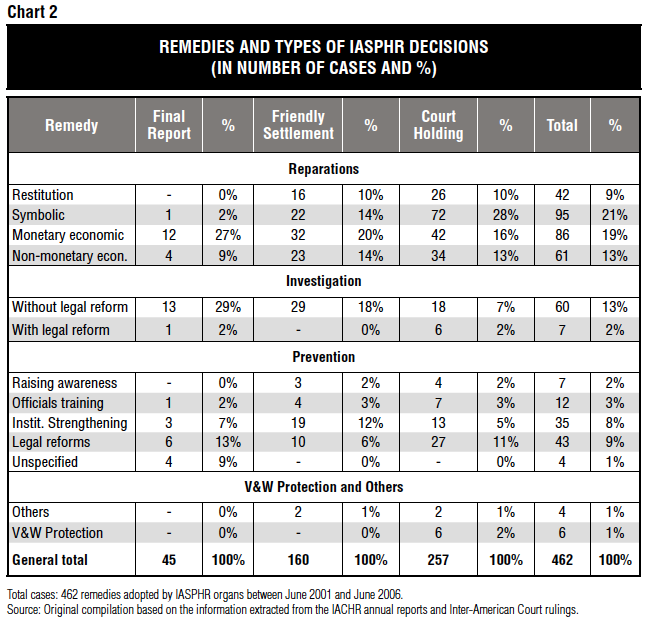
Upon analyzing the degrees of compliance with the recommended, agreed upon, or ordered remedies in the surveyed decisions, non-compliance with half of these remedies is observed. Moreover, total compliance with only 36% of the surveyed remedies and partial compliance with 14% was found.
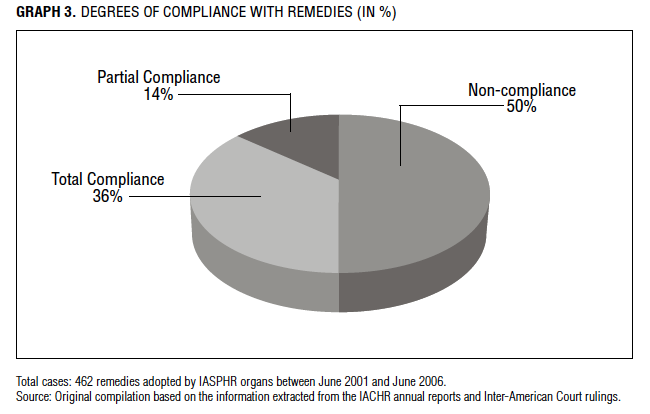
The remedies with the greatest degrees of compliance are those that demand some type of reparation: total compliance is found in 47% of the cases and partial compliance in 13%. In extreme contrast, only 10% of orders, recommendations, or commitments to investigate and punish those responsible for violations were totally satisfied; 13% were partially satisfied, and 76% were not satisfied.
As regards the different degrees of compliance with the different types of remedies, the greatest degrees of compliance were registered in those which required monetary reparations (58%), followed by those of symbolic reparations (52%), preventive measures through raising social awareness (43%) and the training of public officials (42%). However, remedies with the least degrees of compliance are those requiring the protection of witnesses and victims (17%), investigation and punishment of those responsible, regardless of the need of legal reforms (14% and 10% respectively) and those requiring legal reforms (14%). In particular, in cases in which the IACHR has recommended carrying out unspecified preventive measures there has been no compliance whatsoever12.
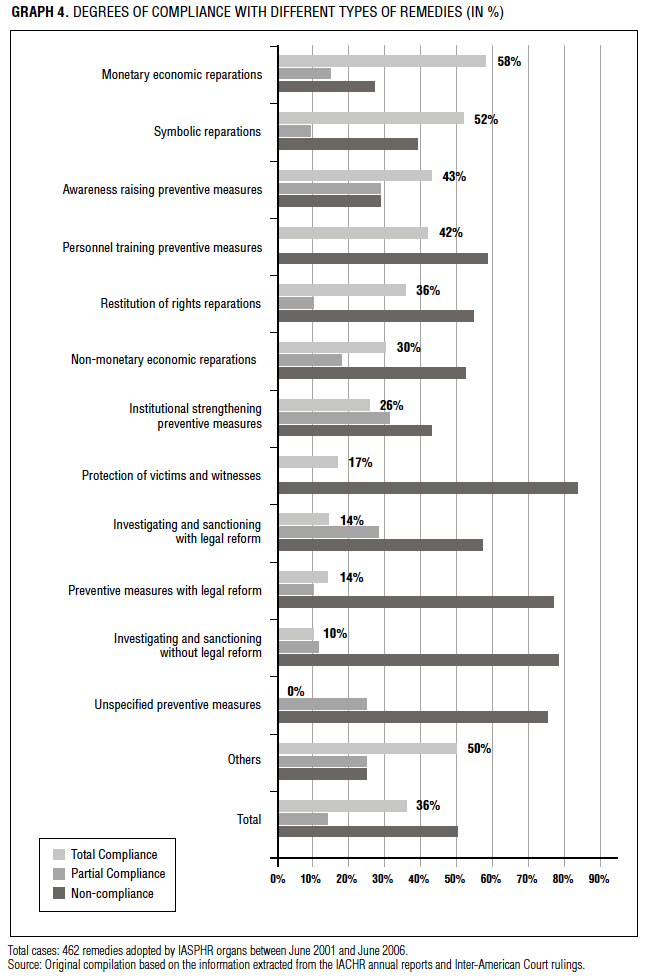
Remedies agreed upon in friendly settlements approved by the IACHR are those that register the greatest degree of compliance13. 54% received total compliance, the highest, albeit not entirely satisfactory, proportion. In contrast, only 29% of remedies ordered by the Court and 11% of remedies recommended in the Commission’s final reports were totally satisfied14.
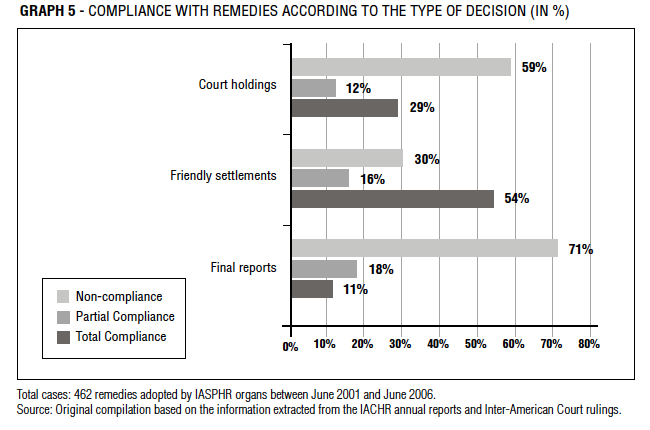
Upon combining the variables listed above, it is observed that the highest percentage of total compliance is verified in monetary reparations agreed upon in approved friendly settlements (88%). Non-compliance is verified at high levels, unfortunately, in all types of decisions and all sorts of remedies. As has been said already, however, a lesser degree of non-compliance tends to be verified for remedies agreed upon in approved friendly settlements. For example, 84% of institutional strengthening measures ordered in Court rulings were not satisfied, and 67% of those recommended in IACHR final reports were not satisfied, while the percentage of non-compliance in institutional strengthening measures agreed upon in friendly settlements is notably lower: 11%. The same can be said of measures aimed at raising social awareness: their level of total non-compliance is 50% in cases ordered by Court rulings and 0% in cases in which they were agreed upon in approved friendly settlements.
Finally, monetary reparations seem to be, in relative terms, the measures receiving the least amount of non-compliance of all types of decisions.
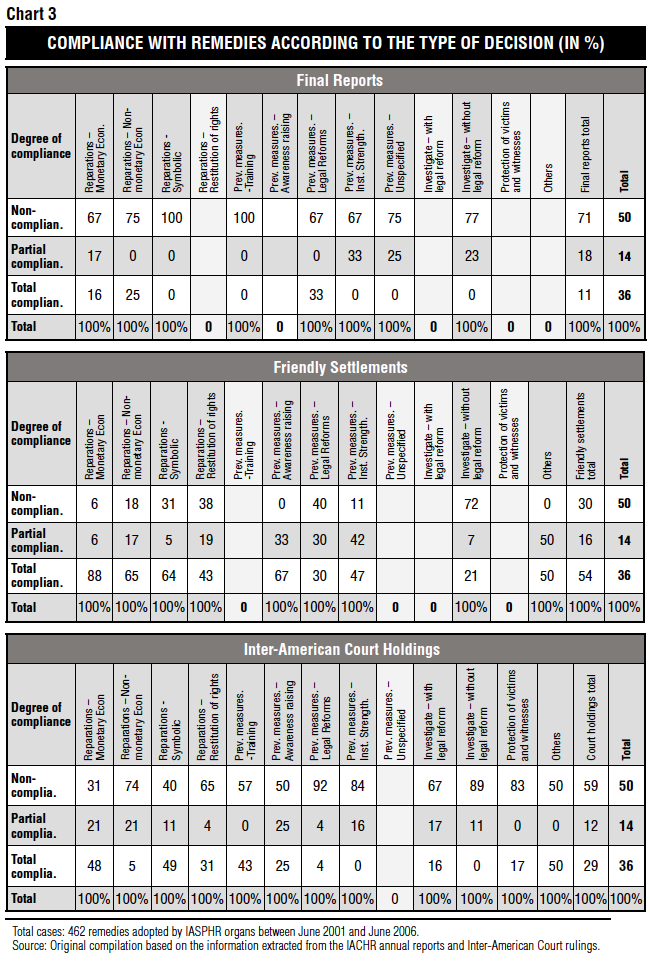
The study of the degree of compliance with the remedies demanded of different states shows that the highest percentages of non-compliance correspond to Trinidad and Tobago, Venezuela, and Haiti. These three states totally failed to comply with the remedies recommended, agreed upon, or ordered by the control bodies of the IASPHR, although it should be noted that in the analyzed sample, the Inter-American Court ruled only twice against Trinidad and Tobago, once against Venezuela, and the IACHR only issued one report on the merits against Haiti. Furthermore, Suriname and the Dominican Republic have a 75% level of non-compliance with remedies, although it should also be clarified that during the period studied, each of these countries had only one Court ruling issued against them. The percentages of non-compliance with remedies following in decreasing order are Paraguay – with 69% non-compliance with remedies – and Colombia – with 68% non-compliance.
On the other hand, the highest percentages of compliance correspond to Mexico (83%), Bolivia (71%) —even though only 2 friendly settlements were approved by the IACHR in the surveyed period— and Chile (59%).
On the other hand, Ecuador, Peru, and Guatemala are the states that received the greatest amount of decisions against them by the IACHR during the surveyed period: 17, 17, and 13 respectively. Peru, Guatemala, Colombia, and Paraguay were states that received the greatest amount of rulings from the Inter-American Court: 9, 7, 5, and 4 respectively.
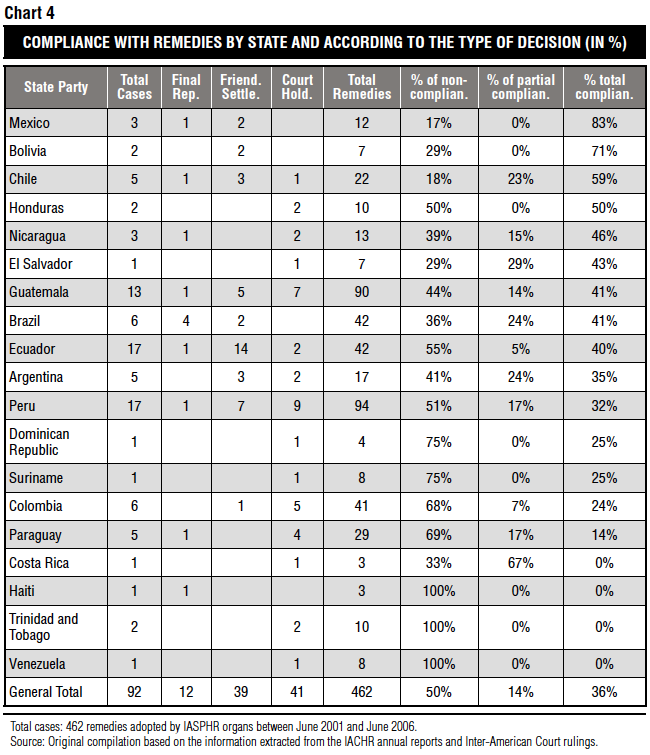
State performance can be broken down for each type of decision issued by the control organs of the IASPHR. The results confirm that – with the exception of Chile, which has a compliance level of 63% of the remedies ordered in Court rulings – states are more likely to comply with remedies agreed upon in approved friendly settlements than in those resulting from the remaining two types of decisions15.
In particular, upon analyzing state performance in compliance with the different remedies categorized by the objectives they pursue, the low level of general compliance with measures to investigate and punish is notorious. Nine countries have a level of complete non-compliance with this type of remedy (this is the case of Argentina, Ecuador, El Salvador, Haiti, Honduras, Nicaragua, Paraguay, Surinam, and Venezuela), while the remaining countries record total compliance only between 9 and 17% of the cases (Peru, Guatemala, Colombia, and Brazil). The sole exception is Mexico, which totally complied with remedies to investigate and punish in 67% of the cases surveyed.
With respect to preventive measures, once again, Mexico stands out with a 100% compliance. The remaining countries have a medium level of compliance (between 40 and 50%; in the cases of Ecuador, El Salvador, Brazil, and Colombia), low compliance (between 7 and 25%; in the cases of Nicaragua, Argentina, Chile, Guatemala, and Peru) or non-compliance (in the cases of Bolivia, Costa Rica, Venezuela, Honduras, and Paraguay, among others).
Bolivia, Chile, and Honduras stand out with a 100% compliance with the surveyed reparation measures. They are followed by Mexico (86%), Ecuador (67%), and Nicaragua (63%). On the contrary, countries such as the Dominican Republic, Colombia, and Paraguay registered low levels of compliance with these remedies (33%, 21%, and 15%, respectively). Other states show complete non-compliance with reparation remedies included in the sample: Costa Rica, Haiti, Trinidad and Tobago, and Venezuela.
The analysis of the level of compliance of each state with different types of remedies leads to the conclusion that preventive measures demanding the strengthening, creation or reform of public institutions were only satisfied to some extent by Brazil, which had fully complied with 64% of the cases. The other eleven states to which the IASPHR bodies recommended or ordered this type of measure totally failed to comply with them in all cases.
As regards measures for legal reform, they received full compliance in all cases in which they were ordered for Mexico and Ecuador. Another 4 states had a low level of compliance with these measures (Argentina, 33%; Chile, 25%; Nicaragua, 25%; Peru, 20%) and 9 totally failed to comply.
Finally, Bolivia, Chile, and Honduras have totally complied with all reparation remedies demanded of them, while Trinidad and Tobago, Venezuela, Colombia, Paraguay, and Peru present low levels or compliance or complete non-compliance with these remedies.
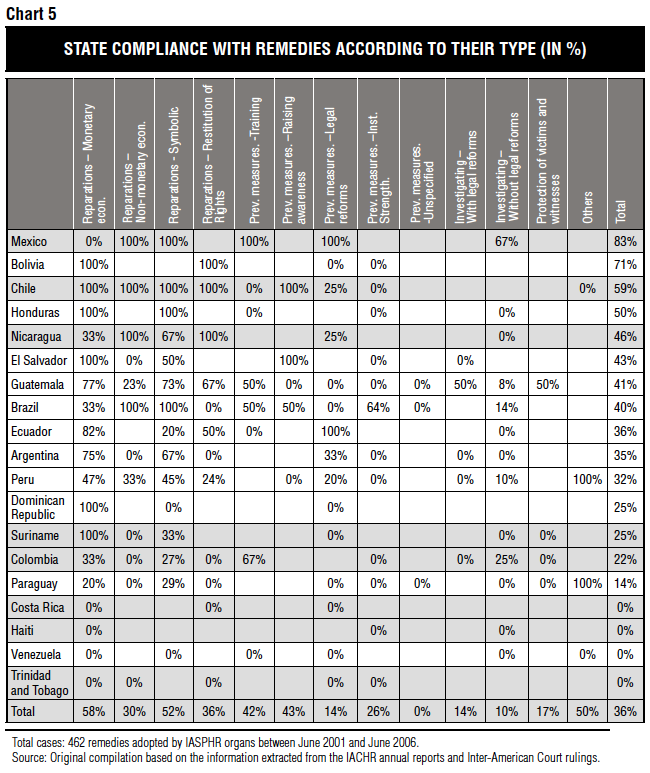
The study of the time states delay in carrying out measures necessary for totally complying with remedies (in cases in which this has happened) yields the following results: the average delay for total compliance with remedies was approximately 1 year and 8 months. Separately, the average time spent for totally complying with remedies recommended by the IACHR in final reports was approximately 2 years and 7 months, and the average time for complying with remedies ordered in Court rulings was approximately 1 year and 8 months.
In the following chart, the average time periods that each state delayed in reaching total compliance with remedies are comparatively reflected.
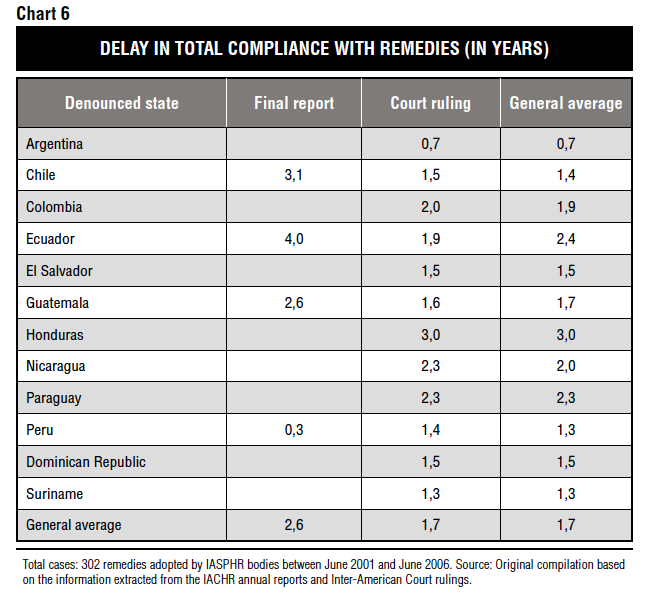
Litigants before the IASPHR were classified in the following categories, in accordance with who presented the petition: a) Individuals (including any person, victim, victim’s family member, attorney); b) Non-governmental Organizations (NGOs) of the denounced state itself (including professional associations and unions)16; c) NGOs acting internationally (operating in states other than the denounced state or not only in the denounced state); d) The Ombudsman Office of the denounced state; and e) University legal clinics.
In 34% of the cases surveyed, a national NGO was the litigant, in some cases, along with individual petitioners and/or legal clinics. 30% were litigated by a combination of at least one international NGO and one national NGO, at times together with individual petitioners and/or legal clinics. 12% of the cases were litigated by an international NGO, either together with individual petitioners and/or legal clinics or not. Individual petitioners litigated only 20% of the cases. In 4% of the cases, Ombudsman Offices were the litigants, but only as sole petitioners in 2% of the cases. Legal clinics presented 5% of the cases, although they were always accompanied by an international NGO and in some cases by a national NGO as well.
The remedies established in cases in which litigation was brought forward by an international NGO have a lower level of total non-compliance (40%) than the average level of total non-compliance (50%), even though this is not a significant difference.
In turn, even though the cases litigated by the Ombudsman’s Office that entered into the sampling are scarce (4%), they register a level of total compliance that is noticeably greater than the average: 71.4% versus 35.7% of the total cases.
The average duration of proceedings, from when the petitions enter into the IASPHR until their resolution is approximately 7 years and 4 months. The median is 6.7 years (approx. 6 years and 8 months.), which means that half of the cases are resolved in 6.7 years or less, while the other half takes 6.7 years or more before they are resolved.
In turn, the processes solved through friendly settlements agreements have a shorter average duration than the processes completed through Court rulings or the Commission’s final reports on the merits.
Grouped by time intervals, 88% of cases were resolved with a delay that is greater than or equal to 4 years. In turn, 25% lasted from 4 to 6 years, and 34.8% from 6 to 8 years, and 28.3% were resolved in more than 8 years.
42% of the cases that ended with an IACHR final report lasted from 5 to 8 years. 33% of them lasted from 7 to 11 years and 17% lasted more than 11 years. The proceedings in more than 56% of the cases finalized by a Court ruling lasted from 5 to 8 years, and 14% of them lasted from 2 to 5 years, another 15% went on for 7 to 11 years, and another 15% lasted for more than 11 years. As regards the proceedings concluded through the approval of a friendly settlement, 39.5% took around 5 to 8 years before a settlement was reached, 26% lasted from 2 to 5 years and 16% did so in less than 2 years. 10.5% of the cases delayed 7 to 11 years before a settlement was reached. Considering all the decisions that put an end to the proceedings, 47% of them took from 5 to 8 years since the proceedings started.
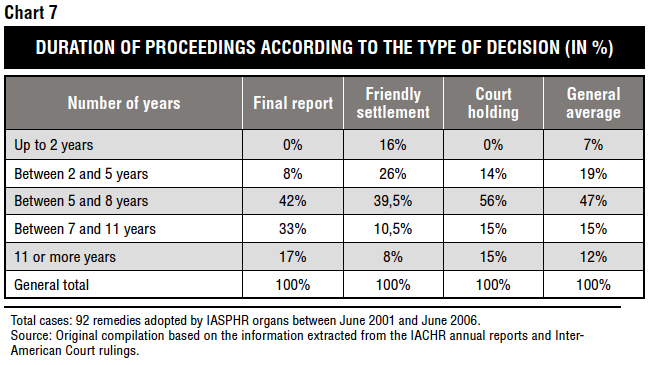
Full compliance with the decisions of the IACHR and the Inter-American Court constitutes an essential element to ensure the full force of the ACHR in the region. Furthermore, it is an obligation that the states themselves assumed upon ratifying the Convention (ACHR, 1969a, 1969b) , deriving from the fundamental principle of compensating harm and the principle of good faith in the observance of treaties ( VIENNA CONVENTION ON THE LAW OF TREATIES, 1969) . The information surveyed in this research project, however, suggests that such actions are not as strongly implemented as the rules require.
The variety of the remedies adopted by the IACHR and the Inter-American Court seems to confirm the widespread vision that the objectives sought by the IASPHR are, with relatively few exceptions, to make reparations to affected persons or groups, to take measures to avoid repeating detected rights violations, and to give protection to victims and witnesses. As has already been pointed out, the objective of making reparations to affected persons or groups predominates. Not only is it the most usual type of remedy, but it is also the one that seems to receive the greatest proportion of state compliance. In particular, the means most frequently employed are measures of symbolic reparation —especially in Court rulings— and monetary and non-monetary economic reparations.
In recent years, IASPHR bodies have evolved in their determination to make reparations through broadening the type and variety of remedies ordered. This evolution is observed, above all, in the rulings of the Court, which has drafted important jurisprudence beyond the mere pecuniary aspect in the pursuit of complete reparation for the harmful consequences of rights violations. The IACHR has also made progress in this area, especially with regards to friendly settlements. Due to its nature, this type of proceedings allows the determination of more specific measures, with the potential of better guaranteeing the complete satisfaction of victims.
Non-compliance with measures required by the IASPHR has been shown to be notably widespread. Half of the remedies recommended, agreed upon, or ordered in the decisions surveyed were not satisfied and only 36% of them were totally satisfied. Only in exceptional cases, moreover, after a long period of time total compliance occurs. On average, Inter-American proceedings require more than seven years from when the petition first enters the system until a final decision. To this, the average period of time that states delay in complying totally or partially with the required remedies (when they do so) is approximately 2 and a half years for final reports, and a little more than a year and a half for Court rulings. These time periods are excessively long and may generate distrust and frustration among the users of the IASPHR17. If the large number of petitions and subjects received is considered, it is clear that in many cases, the IASPHR does not offer an effective and timely answer for those affected.
One possible explanation —that we have not explored in this study— for diverse levels of compliance depending on the type of measure ordered may be associated with the characteristics of the state entity in charge of its implementation. In many cases, the office responsible for state foreign relations before the IASPHR is different than the office that should be involved in implementing the required measures. For example, in the cases in which the modification of a law was required, the Executive may push for reform, but the measure will only be satisfied by means of the intervention of the Legislative, in which, in turn, diverse political forces must reach a consensus. Something similar happens with decisions that require the investigation and punishment of those responsible for human rights violations. The Executive may urge compliance with said measures, but, generally, the only branch with authority to carry out compliance is the Judiciary. If this description is realistic, it should not surprise us that the remedies that require orders from offices pertaining to different branches of government record lower levels of compliance, as compared to monetary compensation and other measures the implementation of which generally are the responsibility of the Executive Power, in charge of relations with the IASPHR.
The relatively low degree of compliance with recommendations made in final reports by the IACHR leads to the conclusion that said form of resolving cases is not the most effective one, even when there are understandable reasons not to submit a case to the Court. The rate of compliance with remedies ordered in Court rulings is also low, but it is greater than the number of remedies included in final reports of the IACHR. The relative effectiveness of friendly settlements, in turn, tends to strengthen the idea that the IACHR should dedicate the greatest amount of effort possible to promoting these agreements. This mechanism seems to provide the petitioner the possibility of a faster and more effective solution than that which could eventually be obtained though a final decision of the Commission.
The results of this research also suggest that the intervention of an international NGO in proceedings before the IASPHR has a slight yet positive influence on subsequent state compliance with recommendations. One possible explanation may indicate that an expert NGO may have, unlike an individual litigant, greater technical and structural resources for exercising pressure on states, not only at the moment of negotiating the clauses of the friendly settlement, but also when demanding effective compliance with them. Compliance also tends to increase when the litigant before the IASPHR is the Ombudsman’s Office of the state party, although this has been verified by a very small sample of cases. This may perhaps be due to the greater ability of these offices to carry out the steps and lobbying necessary with different powers and state agencies with decision-making powers for implementing measures. These research results may suggest, therefore, the necessity for greater involvement of ombudsman’s offices in general in litigating rights at the Inter-American level, consolidating a still incipient trend. The results also shed light on the relevance that these state bodies may have on the internal implementation stage of IASPHR decisions, independently of their prior intervention.
Finally, formulating a conclusive assessment with respect to each state’s performance is a complicated task. Intuition indicates, certainly, that states have many characteristics that may make observance of an IASPHR measure more or less probable. For example, it may be thought that federal states face some additional complexities in the way to compliance. Federalism, in and of itself, therefore, may constitute a difficulty for compliance with measures required by Inter-American bodies. In fact, some states have state or province officials as part of their delegations before the IASPHR protection bodies with the objective of involving them and committing them to complying with recommendations and orders. Nevertheless, it is doubtful that this research will offer conclusive material for sustaining such an affirmation. Other state characteristics may also be considered as being associated with levels of compliance with remedies, such as the degree of consolidation and the quality of their democratic institutions, their trajectory, and commitment to the IASPHR, their economic situation, etc.
Regardless, this research offers an objective and reasonable foundation for discussing, in each case, the performance of each state in relation to the IASPHR. Of course, the IASPHR’s influence is a subject that deserves a great deal of study beyond the levels of compliance with remedies adopted by its bodies and types of state behavior. It is also clear that the limited focus of this research, as in any theoretical endeavor, may overlook some important aspects. Nevertheless, the research offers an argumentation perspective and an objective foundation cited by the specialized literature, that allows for states to be questioned: remedies adopted in the framework of the petition-based system must be obeyed and if the degree of compliance exposed in this research is not satisfactory, it is principally due to states not behaving in a satisfactory manner.
Naturally, during the development of this research, several hypotheses associated with the possibility of increasing compliance with IASPHR decisions have arisen. Below, some of them are briefly presented. Even though they are not observations that are directly linked to the statistical information presented, they are intimately related to the problem of the IASPHR effectiveness. It is possible that similar inquiries to the one presented here will contribute to a more thorough discussion surrounding this problem.
First, the discussion of possible reforms to the Inter-American system must include a chapter regarding the reforms necessary for increasing degrees of state compliance with the decisions of the bodies of the IASPHR. One possible approach to be explored consists in breaking down obligations with broad contents that present low levels of compliance, such as investigating and punishing. For example, the opening (or reopening) of investigations, on the one hand, and the punishment of those responsible for the crimes, on the other, could be required separately. In this sense, more specific orders or recommendations may facilitate control over the diverse mechanisms through which both obligations may be satisfied. Innovations in this field appear necessary, in the investigation and punishment of human rights violations, being one of the remedies most required by the IASPHR organs with the lowest levels of compliance.
It appears to be of crucial importance that states establish a national space of coordination between the different powers in order to increase the possibilities for effective and timely compliance (DULITZKY, 2007, p. 40; IDL et al., 2009, p. 16) . In terms of academic research, there are no further studies focusing on the incidence of national mechanisms on levels of compliance. Similarly, it has also been suggested that states should adopt formal mechanisms for the effective implementation of international decisions, establishing through constitutional, legal, or jurisprudential means their binding nature, and that they incorporate in public-policy making and in solving legal cases the standards developed by the Commission and the Inter-American Court in the interpretation of the American Convention.
One possible reform for strengthening the friendly settlement proceedings is aimed at modifying the practices of the IACHR in response to non-compliance with these settlements (IDL et al., 2009, p. 15 and ss). None of the provisions of the ACHR makes reference to the consequences derived from failing to comply with the agreement or whether, under such situation, the case should be deemed as closed. In practice, if the state fails to comply with an approved friendly settlement, the case is not sent to the Inter-American Court. Therefore, it has been said that from the point of view of the petitioner, selecting the friendly settlement route may be a disadvantage in comparison with the option of the contentious route. So as to not obligate the petitioner to make a prior evaluation of risks of the case’s resolution, the IACHR may similarly treat non-compliance with a report on the merits and the friendly settlement. This means that if after the fulfillment of the terms established in the friendly settlement reports, the state, or a party to the settlement, fails to comply with all or in part with the settlement, the IACHR may reopen the matter and continue with the proceedings as though a friendly settlement had not been reached and, eventually, send the case to the Court. Otherwise, the Commission must decide to issue the report established in Article 49 of the ACHR, only when the commitments assumed in the settlement have been fully satisfied. Moreover, the possibility that, in response to non-compliance with commitments the case could be sent directly to the Court would generate an additional incentive for the state to make its greatest efforts in order to find a way to comply with its obligations18. Finally, while the ACHR does not provide any guidelines regarding the manner in which the Commission and the parties should proceed at this stage19, this could be specified by means of regulations. The possibility that the IACHR could be authorized for setting the terms of the friendly settlement could even be considered, although it is not a possibility that is currently established in any provision.
Another suggested option is that of unpacking the IACHR’s mandate – and especially, adjusting its role in the contentious stage20 – which would allow it to strengthen its political role (promotional tasks and technical assistance) and its participation in friendly settlement proceedings, which seem to be the most effective21. In this study, it was confirmed that the percentage of state compliance with approved friendly settlements is elevated. Therefore, it is vital to insist on the need for the IASPHR to carry out all the reforms that, directly or indirectly, will strengthen this case solving method. If, for example, the IACHR were able to limit its participation during the contentious stage, it would be further available to exert a more active role during the friendly settlement process, thus reinforcing its powers and capabilities as mediator and its political and diplomatic role, relevant at this stage of the process. In this way, the IACHR might also carry out a more exhaustive follow-up during the implementation stage, periodically review the commitments assumed, visit the countries regularly and hold frequent work meetings with state and petitioner representatives.
Finally, it seems fundamental to strengthen the control, monitoring, and follow- up capabilities of the system’s bodies. Especially, the IACHR, in its role of political organ and main human rights protection promoter in the region, should boost the actions aimed at ensuring an compliance with its decisions as well as those dictated by the Inter-American Court. Furthermore, the General Assembly of the OAS should take a more active role in this matter, by eventually applying costly political sanctions to the states which are reluctant to comply with the measures ordered by the organs of the IASPHR.
The IACHR could issue rules with specifications regarding the level of compliance demanded by each remedy in particular. The current practice, in which the IACHR does not evaluate the level of compliance with each recommendation, generates a perception of superficial control. This especially happens with respect to recommendations drafted in terms that are vague or too broad, for example, such as those that recommend that the state “ adopt the necessary measures to avoid similar events in the future”. This, together with the lack of clear and uniform criteria for all cases when evaluating the level of compliance with the recommendations, may constitute an important obstacle for effective compliance with the remedies ruled by the IACHR. If the Commission declared, for example, that the state failed to comply with a recommendation, since the measures adopted were insufficient, the state could take notice of the IACHR’s opinion to this respect and thus guide its actions in accordance with said opinion. The same would happen if the IACHR declared that a measure has been partially satisfied: the state would know that there are measures that still need to be adopted and it would lead its efforts to fully satisfy the recommendation. Finally, the evaluation of the level of compliance with each recommendation in particular would prevent the sorts of contradictions that often arise when, on the one hand, the petitioners consider that a specific recommendation has not been satisfied at all or it has been partially satisfied and, on the other, the state shows that it has been fulfilled. In these cases, it is fundamental that the IACHR rules on the controversy in question and makes its point clear in the matter.
The evaluation of state compliance carried out by the Court should also be based on clearer and more uniform criteria. Today, the Court limits itself to evaluating state action with respect to each measure ordered, without clearly defining each category used (total, whole, or full compliance, partial compliance, or pending observance). This is particularly important in the cases in which the petitioners express their disagreement with the way the state complied with a specific order and, nevertheless, the Court declares that it has been fully satisfied. It has been detected that in many cases, the Court does not account for the reasons of such decision. This is probably due to the fact that it does not make the criteria for determining the degree of compliance with ordered measures public. In these cases, so as to avoid feelings of injustice or frustration among the petitioners, the Court should at least account for its reasons to conclude that an order has been observed, despite the discontent expressed by the petitioner. Beyond this, specifying the content of the evaluation criteria would grant greater transparency, security, and uniformity to the follow-up process of the ordered measures.
1. From the OAS adjusted budget for 2009, 4.1% is set aside for the IACHR and 1.97% for the Court. Ever since the approval of the reforms to the IACHR and the Court’s regulations in 2000, the percentage of the OAS total budget set aside for the two bodies has increased little more than 1% of the total, in almost ten years, going from 5% in 2000 to 6.07% in 2009. Information available at: <http://www.IACHR.org/recursos.sp.htm> and at <http://www.corteidh.or.cr/donaciones.cfm>. See also, Robles (2005, p. 23-24, Annex 1) and Ayala Corao (2001, p. 113).
2. Cfr. . On March 5, 2009, the CPJA held a special session with civil society on the Inter-American human rights system. The evolution of CJPA’s work and diverse proposals may be consulted at <http://www.oas.org/consejo/sp/CPJA/ddhh.asp#dialogo>.
3. We should not overlook that the concept defined herein as remedy is referred to as reparation in the practice of the IACHR. We have decided to use the term remedy, commonly used in the Anglo-Saxon legal universe, so as to avoid confusion in the description of the objectives pursued by the IACHR and the Inter-American Court when ordering or recommending conduct for states: only some and not all of those requirements pursue strictly reparatory purposes of past violations; others seek to prevent future violations or other specific purposes such as the protection of victims and/or witnesses. The use of the term remedy instead of reparation makes a distinction between those measures seeking reparation in the strict sense, as defined in this section, and all other measures.
4. In the cases without information about the date of compliance with a determined remedy we have taken the date of the annual report of the IACHR or of the resolution of the supervision of the judgment of the Court that declared the total or partial compliance with the remedy, as this is the first date in which the compliance is mentioned. In cases of partial compliance with remedies, the date of the last concrete action adopted by the State towards compliance is entered. Therefore, the results related to the delay in complying with remedies must be red in approximate terms.
5. In cases of multiple petitions, the initial date was recorded as the date of the presentation of the first petition.
6. The closing date for the research was June 30, 2009.
7. This information has been gathered from sections from the annual reports referring to the state of compliance with the recommendations of the IACHR.
8. All of the charts with surveyed data and classification decisions are within the authority of the DC and may be requested..
9. For surveying purposes, in the cases in which the payment of sums of money for diverse compensatory matters and costs was indicated, the duties were unified as though they dealt with one sole remedy demanded of the state.
10. This category does not include measures such as campaign launching or general media programs. This type of measures corresponds to the iv category. On the other hand, these remedies are different than those classified in categories i and ii because they have a declarative rather than patrimonial content.
11. Or, at least, in which the IASPHR bodies have not made mention of the existence of this type of barrier.
12. Of course, the indeterminacy of the order generates distrust of the evaluation. How can compliance with these recommendations be verified? Is it necessary that the violation effectively not repeat itself or is it enough for the state to do something concrete, albeit inefficient, in seeking prevention?
13. To highlight the highest degree of compliance with the remedies agreed upon in approved friendly settlements is not the same as concluding that the remedies agreed upon in friendly settlements (whether or not they have been approved) are those that are satisfied the most in general terms. As indicated in section II.1., only approved settlements have been able to be surveyed, given that they are the only ones made public. Thus, the level of compliance with unapproved settlements has not been able to be evaluated. With the lacking data, more solid conclusions could be arrived at regarding the degree of effectiveness of friendly settlement proceedings as a means of resolving contentious cases.
14. The generally poor results in terms of effectiveness do not obey the low commitment of only a few states with many complaints before the system. The survey confirms that, even excluding the measures issued against the three states with the most complaints against them in the surveyed period – Peru, Guatemala, and Ecuador – from the general calculations, there are not significant changes. Even though, by excluding these countries from the calculations, a greater percentage of total compliance with remedies agreed upon in approved friendly settlements is observed (increasing from 54% to 65%), lower levels of compliance are also recorded in compliance with the remedies ordered in Court rulings (from 29% compliance decreases to 25%) and remedies recommended in final reports (decreasing from 11% to 4%).
15. As regards the degrees of compliance with remedies recommended in final reports of the IACHR and those ordered in the holdings of the Inter-American Court, it is observed that the states that had greater degrees of compliance with remedies ordered in holdings of the Inter-American Court are Chile, Nicaragua, and Honduras, and the states that had greater degrees of compliance with remedies recommended in final reports of the IACHR are Ecuador, Guatemala, and Peru.
16. In cases in which an NGO was present in representing victims or family members, the litigant considered for statistical purposes was only the NGO. In cases in which individual petitioners as well as NGOs were present, the participation of both was taken into account.
17. We should not lose sight of the fact that most of these cases have already undergone extensive domestic proceedings.
18. The aforementioned proposal for reform also indicates that it is fundamental that the IACHR improve the factual and legal content of friendly settlement reports in order to put them on the same level as reports on the merits and thus avoid that these differences in the content of both reports discourage petitioners from turning to friendly settlements. This is because the reports of Art. 49 of the ACHR are limited to transcribing the settlement reached without presenting a determination of facts or doctrinal developments regarding the violated rights.
19. By means of the Statute and Rules of Procedure of the IACHR, essential procedural aspects of the conciliation proceedings have been regulated, but these provisions are not sufficiently precise.
20. CEJIL considers that the IACHR could cooperate more with the Court, given the debates of fact, law, and reparations that arise following the submission of a case; and respond to specific requests of the Court regarding these matters (CEJIL, 2005, p. 26). Other proposals are aimed towards considerably limiting IACHR intervention in the contentious stage; only the victim and the victim’s representatives would litigate before the Court against the State; the IACHR would limit itself to fulfilling the role of an assistant in the search for justice with the authority to question the parties, present its point of view, its legal opinion, and propose a solution for the case; in the prior stage its role would only consist in adopting reports of admissibility and opening a friendly settlement process (DULITZKY, 2007, p. 37). The most radical proposals raise the need for the IACHR to directly not intervene in the proceedings before the Court. These latter proposals have received numerous criticisms from diverse actors related to the IASPHR (CEJIL, 2005, p. 25; IDL et al., 2009, p. 4).
21. See the clarification in note 16.
Bibliography and Other Sources
AMERICAN CONVENTION ON HUMAN RIGHTS (ACHR). 1969a. Article 51.2.
______. 1969b. Article 68.1.
AYALA CORAO, C. 2001. Reflexiones sobre el Futuro del Sistema Interamericano de Humanos [Reflections on the Future of the Inter-American System of Human Rights]. IIHR Journal, San José, n. 30-31, special edition.
DULITZKY, A. 2007. 50 años del sistema interamericano de derechos humanos: una propuesta de reflexión sobre cambios estratégicos necesarios [50 years of the Inter-American Human Rights System: A proposed reflection about necessary strategic changes]. IIHR Journal, n. 46, Jul./Dec. 2007, p. 31-40.
IDL et al. 2009. Comentarios sobre las propuestas de reforma del Sistema Interamericano de Protección de Derechos Humanos [Comments on proposals for reforming the Inter-American System of Human Rights Protection]. Presented before the CPJA of the OAS on March 5.
MÉXICO. 2008. Reunión de México para el fortalecimiento del sistema interamericano de derechos humanos [Meeting in Mexico for strengthening the Inter-Amerian human rights system]. Cuestiones y tendencias fundamentales identificadas por el presidente de la reunion [Fundamental issues and trends identified by the meeting’s president]. CP/doc. 4329/08 corr. 1.
ROBLES, M.E.V. 2005. La Corte Interamericana de Derechos Humanos: la necesidad inmediata de convertirse en un tribunal permanente [The Inter-American Court of Human Rights: the need for it to immediately transform into a permanent court]. CEJIL Journal, n. 1, p. 12-26.
VIENNA CONVENTION ON THE LAW OF TREATIES. 1969. Article 27. U.N. Doc A/CONF.39/27 (1969), 1155 U.N.T.S. 331.